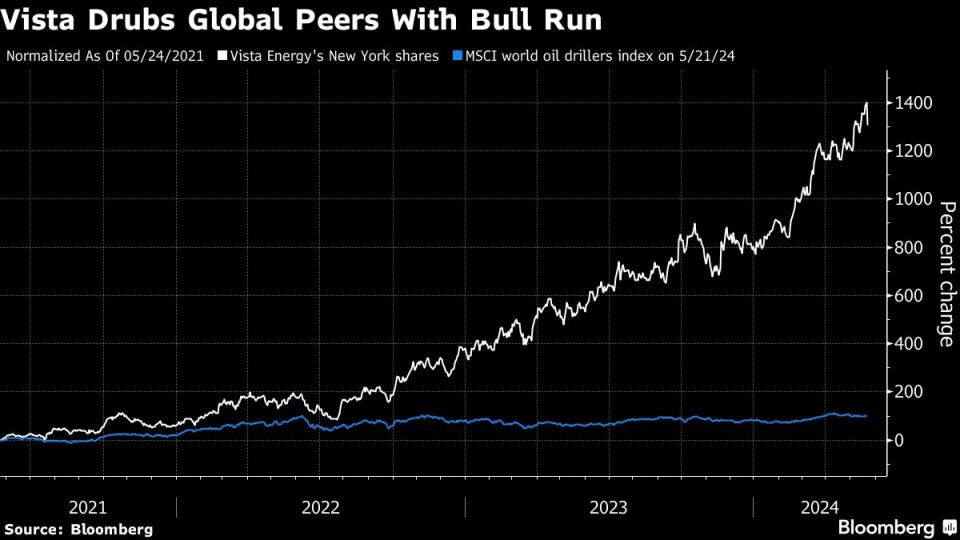Oil Driller’s 1,400% World-Beating Rally Hinges On Milei Reforms
(Bloomberg) -- Miguel Galuccio knows shale.
Most Read from Bloomberg
Harvard Students Walk Out of Commencement Protesting Suspensions
Stocks Join Bonds in Falling as Fed-Cut Bets Wane: Markets Wrap
Israel to Restart Gaza Talks After Hostage Video Sparks Outrage
Citi Trader Got 711 Warning Messages Before Sparking Flash Crash
He was a founder of Argentina’s burgeoning boom, leading the first incursions into its heralded oil and gas field known as Vaca Muerta, or dead cow. The shale patch stood idle for nearly a century after its discovery until Galuccio took the reins at state-run YPF SA.
But it wasn’t until Galuccio started his own venture, Vista Energy, that oil really started to flow from the reserves tucked into an arid western edge of Patagonia. And he’s made a fortune in return. Vista’s New York-traded shares are up about 1,400% in the past three years, easily beating every other of the roughly 100 global oil drillers worth $1 billion or more. Galuccio’s 7.9% stake is now valued at some $370 million.
The next chapter — for both Vista and Argentina, with its ambitious industry-wide plans to ramp up crude exports — now lies not just in Galuccio’s hands, he says, but in those of President Javier Milei.
Milei, who’s just months into a four-year term, pledges to go where no Argentine leader has successfully ventured for three decades by deregulating the country’s tightly controlled economy. But his signature legislation, which would stamp his libertarian vision on the economy — including free oil markets — still needs to win approval in congress. And Milei hasn’t yet managed to scrap restrictions on importing equipment and money flows, which are the bane of investors.
At stake are the plans of Argentina’s shale leaders who forecast that daily production of crude alone in Vaca Muerta can reach 1 million barrels in 2030, about triple what it is today. That’s of no small consequence to a world predicted to consume near-record amounts of the fuel in the years ahead, especially when there are few oil fields left on the planet that can generate that kind of growth.
Read More: Oil Demand Outpaces Expectations, Testing Calculus on Peak Crude
“If we want to grow to 1 million barrels, we have to add five rigs every year, and making Argentina even more investable is required to do that,” Galuccio said in an interview at Bloomberg’s headquarters in New York.
Milei — like three straight governments before his that also promoted shale drilling — has a vested interest in unleashing Vaca Muerta since crude is a relatively quick route to bringing extra export revenue to Argentina. Those billions of dollars are vital to turning around an economy that’s headed for its sixth recession in a decade.
“He has that North Star, and he’s going in that direction no matter what,” Galuccio said, referring to Milei’s pro-business ideology.
But some of Milei’s progress has been slower than investors would like as he contends with high inflation. In particular for shale drillers, said Nicolas Gadano, chief economist of Buenos Aires consultancy firm Empiria, barrels of oil in Argentina still fetch less than global benchmarks and capital controls remain in place.
“Milei, on the purely pragmatic grounds of trying to slow inflation, is beginning to moderate or backpedal on his convictions, and that’s a yellow traffic light,” Gadano said. “Continued capital controls mean that, while Vista can still invest its cashflow, it’s very difficult to scale up spending or for other companies to bring in new investments.”
Read More: Milei Seeks Free Oil Markets by Law in Shale-Rich Argentina
Argentina currently produces more than 350,000 barrels a day of shale oil — it exports one third — and, during the height of winter demand, the equivalent of another 500,000 barrels of shale and tight gas. That’s just a fraction of what drillers churn out in the prolific Permian Basin in the US. But it’s been enough to make Galuccio rich.
“Vista was able to show great economics in their shale areas and continually out-deliver guidance, justifying the share rally, despite rich trading multiples,” said Oriana Covault, a research analyst at Balanz Capital in Buenos Aires.
Son of a Shopkeeper
The son of a shopkeeper from a farming province, Galuccio trained to be an engineer in Buenos Aires and took jobs early in his career in Argentina’s far-southern oil fields and the US. At 56, he now sits on the board of SLB, the huge oilfield-services provider. He founded Vista in 2017.
Whatever happens with Milei’s efforts to implement sweeping reforms, Galuccio said Vista investors should bank on the company meeting its output guidance of 100,000 barrels of oil and gas a day in 2026.
“We will deliver on our 2026 plan,” he said. “Anything else that comes will make us more investable, and it will probably give others opportunities.”
While Vista — which counts a United Arab Emirates government outfit as its biggest shareholder — has helped catalyze growth in Vaca Muerta, YPF remains comfortably the biggest producer. Under new management appointed by Milei, and spurred by pipeline buildouts, the state-run driller is poised to accelerate shale operations.
Exxon Bids
Meanwhile, a bidding war that includes Vista is under way to acquire shale oil blocks that Exxon Mobil Corp. once planned to develop.
Exxon is exiting Vaca Muerta as it focuses its efforts elsewhere, including Guyana. It’s an example of how Big Oil has dabbled in, rather than embraced, Argentine shale. The companies have been turned off by government meddling in oil prices and exports — but especially by the money controls that prevent them from freely sending their cash out to other countries.
That’s why Galuccio is so keen to see them gone.
“Easing capital controls will probably be the main single factor enabling Argentina to accelerate development of Vaca Muerta,” Galuccio said.
--With assistance from Shin Pei and Maria Elena Vizcaino.
Most Read from Bloomberg Businessweek
The Dodgers Mogul and the Indian Infrastructure Giant That Wasn’t
A Hidden Variable in the Presidential Race: Fears of ‘Trump Forever’
©2024 Bloomberg L.P.

 Yahoo News
Yahoo News 


